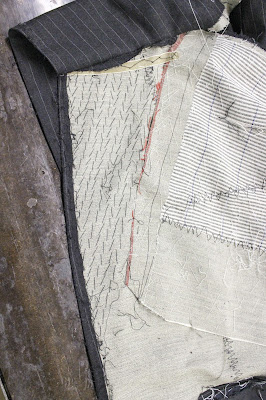A story, translated (and slightly condensed) from the website of the tailor who made the suit we most recently dissected.
If i recall correctly, about ten or fifteen years ago I was visited by a client who was not particularly elegant but who was wearing a suit from a very famous and expensive brand. Despite the expensive suit, he seemed to me to be a mannequin in grey chalk stripes. The client, who was given my name by one of my Roman clients, looked at me, perplexed, and asked me to make him a suit like the one he had on. "A manager's suit", he whispered to me. I had him remove his jacket, and started taking measurements.
Two or three fittings later we had a nearly completed suit. I could tell that he was not satisfied because he asked me to make modifications which, to me, made no sense. I proceeded to mark the suit up with chalk but made no actual changes. In a month I finished his blue cotton suit, three buttons rolled to two in the traditional Neapolitan fashion, manica a camicia [shirt sleeves] and patch pockets.
He tried the suit on for a moment, and not feeling satisfied with what I had done, told me it felt wrong, then that it was too tight, that the shoulders were too wide.
A disaster!
I saw him again three weeks later. He had one his blue suit, telling me that he had been wearing it for a week because, for the first time, he felt a complete liberty of movement and that, as a result, he could no longer wear his older suits. He ordered three more suits.
A Neapolitan suit is like a drug that causes dependency at without which, once hooked, one can no longer do without.
There may be a great deal of truth to this story.
It is important to remember that most tailors learned and perfected their craft long before the advent of the internet. A tailor working in a shop in southern Italy would not often have the chance to see the work of other tailors, particularly those from other parts of the world. Regional characteristics were fairly common because most tailors operated in a sort of stylistic bubble; remember how Domenico Caraceni, often called the father of Italian tailoring, studied the King of England's castoffs, not to copy exactly but to learn from them and to adapt whatever techniques he found useful. The Asola Lucida, or Milanaise buttonhole are obvious examples of a regional detail. There are very strong resemblances in the interiors (and lapels) of the best Parisian tailors. The curved barchetta breast pocket is another. Jet planes made travel easier, though tailors weren't necessarily the first to be flying around the globe for inspiration or education. The internet changed all that.
Customers are now comparing notes on internet fora, tailors are posting images of their work, and more and more are getting technical. We are sharing and learning from each other. It may well have been that the tailor in question was never very well trained in pocket making or finishing, but had discovered a secret sauce, the perfect combination of cloth, canvas, cutting and other components which made for a fluid, supremely comfortable suit. Maybe this tailor's popularity began to grow, aided in part by the internet, and he gradually began to up his game. I can think of at least one other notable cutter whose work has improved immensely over the last years of his career, no doubt in part due to his exposure to other people's work. The thing is, though, one either needs a more experienced person to point out your failings, and with some luck add a bit of advice on how to correct them, or a great deal of self-awareness and curiosity is required, the kind that causes one to explore the work of others, things that inspire, which perhaps serve to illustrate what one can do a little better... The hard part of the latter option is figuring out exactly how to do it better. It is comparatively easy to spot something wrong, but often very difficult to figure out how to do it right, if you don't have someone to show you, especially in the tailoring world which tends to be a bit dogmatic about the "correct" way of doing things. It's hard to challenge your own notions of the "right" way of doing things, especially when those techniques are working for you, but the only way to grow in a craft is to constantly be asking yourself "what if I am wrong about this?". "What if I did the complete opposite of what I think I know to be right- what would happen then?"
And then have the nerve and the patience to try it out.
It would be futile to try to figure out the exact circumstances surrounding this disaster of a suit, but it makes one think about the sort of detail one begins to overlook when other, more important ones have been perfected. I am also encouraged to know that the tailor in question is no longer churning out such rubbish so somewhere along the line, something good happened.































